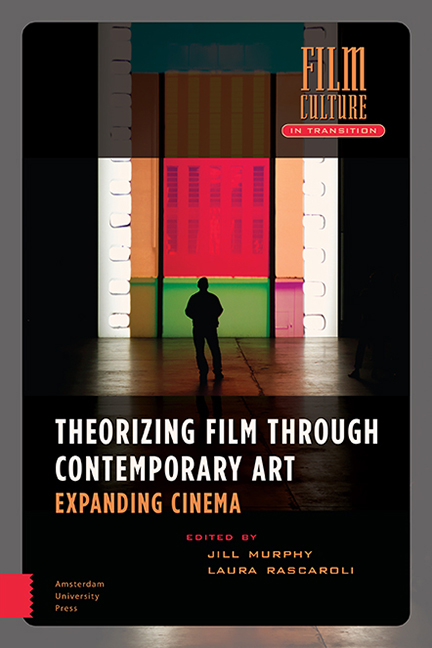Book contents
- Frontmater
- Dedication
- Contents
- List of Illustrations
- Acknowledgments
- Foreword: Courtesy of the Artists
- Introduction: On Cinema Expanding
- Part One Materialities
- 1 Cinema as (In)Visible Object; Looking, Making, and Remaking
- 2 Objects in Time; Artefacts in Artists’ Moving Image
- 3 Materializing the Body of the Actor; Labour, Memory, and Storage
- 4 How to Spell ‘Film’; Gibson + Recoder’s Alphabet of Projection
- Part Two Immaterialities
- 5 The Magic of Shadows; Distancing and Exposure in William Kentridge’s More Sweetly Play the Dance
- 6 Douglas Gordon and the Gallery of the Mind
- 7 A Throw of the Dice Will Never Abolish Chance; Tacita Dean’s Section Cinema (Homage to Marcel Broodthaers)
- Part Three Temporalities
- 8 The Photo-Filmic Diorama
- 9 The Cinematic Dispositif and Its Ghost; Sugimoto’s Theaters
- 10 Time/Frame: On Cinematic Duration
- Part Four The Futures of the Image
- 11 Interactivity without Control; David OReilly’s Everything (2017) and the Representation of Totality
- 12 Post-Cinematic Unframing
- 13 Absolute Immanence
- Index
8 - The Photo-Filmic Diorama
Published online by Cambridge University Press: 23 June 2021
- Frontmater
- Dedication
- Contents
- List of Illustrations
- Acknowledgments
- Foreword: Courtesy of the Artists
- Introduction: On Cinema Expanding
- Part One Materialities
- 1 Cinema as (In)Visible Object; Looking, Making, and Remaking
- 2 Objects in Time; Artefacts in Artists’ Moving Image
- 3 Materializing the Body of the Actor; Labour, Memory, and Storage
- 4 How to Spell ‘Film’; Gibson + Recoder’s Alphabet of Projection
- Part Two Immaterialities
- 5 The Magic of Shadows; Distancing and Exposure in William Kentridge’s More Sweetly Play the Dance
- 6 Douglas Gordon and the Gallery of the Mind
- 7 A Throw of the Dice Will Never Abolish Chance; Tacita Dean’s Section Cinema (Homage to Marcel Broodthaers)
- Part Three Temporalities
- 8 The Photo-Filmic Diorama
- 9 The Cinematic Dispositif and Its Ghost; Sugimoto’s Theaters
- 10 Time/Frame: On Cinematic Duration
- Part Four The Futures of the Image
- 11 Interactivity without Control; David OReilly’s Everything (2017) and the Representation of Totality
- 12 Post-Cinematic Unframing
- 13 Absolute Immanence
- Index
Summary
Abstract
The chapter focuses on a particular type of tableau construction in which the image is built like a glass case display, encapsulating an entire world of its own, combining 2D and 3D effects. With examples ranging from Jeff Wall's light boxes, Gregory Crewdson's and Hiroshi Sugimoto's cinematic photographs, to a case study of Gustav Deutsch's film/installation Shirley: Visions of Reality (2013), the chapter traces the inflections of such a photofilmic diorama as a versatile “cubicle aesthetic” which reconfigures the traditional dynamic of “absorption and theatricality” (Michael Fried) of the tableau form and reveals the imbrication of different art practices. The diverging features of such a dioramic tableau in photography and film are interpreted in terms of intermediality and defamiliarization.
Keywords: Diorama in contemporary art, intermediality, tableau vivant, cinematic photography, photofilmic image, defamiliarization
In an exhibition dedicated to the rediscovery of the versatile forms of dioramas and their influence on contemporary art organized in the summer of 2017 at the Palais de Tokyo in Paris, among the encyclopaedic collection of artworks on display was a photograph composed by the Mexican artist Dulce Pinzón entitled Nostalgia (in fact, a piece from her Historias del Paraíso series, made in 2011–2012). In this picture, also reproduced in the poster of the exhibition, there is a young couple, dressed in the style of the 1950s, kissing in front of a painted canvas background showing a mountainous landscape, which blends in seamlessly with the rocks and dirt under the couple's feet (Figure 25). The whole scene, appearing as a museum display, is being ‘watched’ by taxidermied deer standing in the foreground. With the figures of the embracing couple appearing in the middle of a luminous screen and the deer standing in the shadows as the audience, the whole set-up resembles looking at a cinema screen or being in a theatrical or fairground setting with a revolving stage. Moreover, the spotlight directed at the image may also evoke the technique of Louis-Jacques-Mandé Daguerre's diorama theatre, the nineteenth-century invention that preceded cinema and photography, in which people sitting in pitch darkness could marvel at large semi-transparent paintings, superimposed and lit alternately from the front and back, revealing different portions and layers of the images, and thus producing the illusion of movement, or transition from day to night.
- Type
- Chapter
- Information
- Theorizing Film Through Contemporary ArtExpanding Cinema, pp. 175 - 194Publisher: Amsterdam University PressPrint publication year: 2020
- 2
- Cited by



